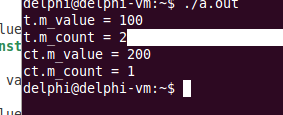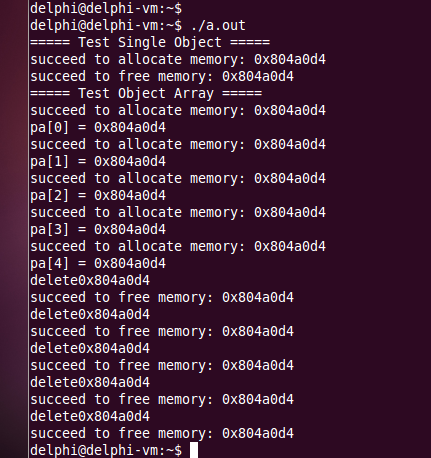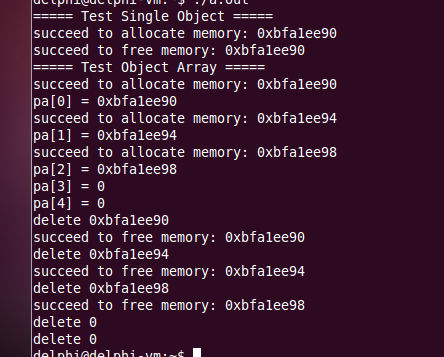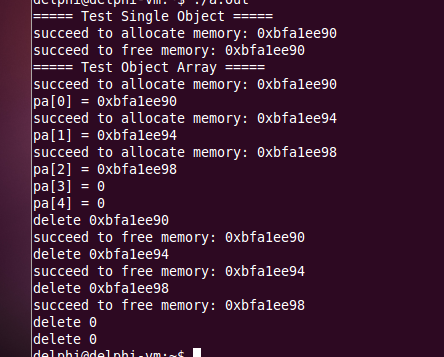1.统计对象中某个成员变量的访问次数
注意:对象(普通对象,只读对象)
eg:
#include <iostream>
#include <string>
using namespace std;
class Test
{
int m_value;
int * const m_pCount;
public:
Test(int value = 0) : m_pCount(new int(0))
{
m_value = value;
}
int getValue() const
{
*m_pCount = *m_pCount + 1;
return m_value;
}
void setValue(int value)
{
*m_pCount = *m_pCount + 1;
m_value = value;
}
int getCount() const
{
return *m_pCount;
}
~Test()
{
delete m_pCount;
}
};
int main()
{
// 普通对象
Test t;
t.setValue(100);
cout << "t.m_value = " << t.getValue() << endl;
cout << "t.m_count = " << t.getCount() << endl;
// 只读对象
const Test ct(200);
cout << "ct.m_value = " << ct.getValue() << endl;
cout << "ct.m_count = " << ct.getCount() << endl;
return 0;
}

2.new关键字创建出来的对象位于什么地方?
答案:可以位于静态存储区,堆去,栈区
new与delete
a.new/delete的本质是c++预定义的操作符(可重载)
b.c++对这两个操作符做了严格的行为定义
new
1).获得足够大的内存空间(默认为堆空间)
2).在获取的空间中调用构造函数创建对象
delete
1).调用析构函数销毁对象
2).归还对象所占用的空间(默认为堆空间)
c.在c++中能够重载new/delete操作符
1).全局重载(不推荐)
2).局部重载(针对具体类进行重载)
重载new/delete的意义在于改变动态对象创建时的内存分配方式
new/delete的重载方式
// 默认为静态成员函数
void* operator new (unsigned int size)
{
void* ret = NULL;
/* ret point to allocated memory */
return ret;
}
// 默认为静态成员函数
void operator delete(void* p)
{
/* free the memory which is pointed by p */
}
new关键字创建的对象位于静态存储区
eg:
#include <iostream>
#include <string>
using namespace std;
class Test
{
static const unsigned int COUNT = 4;
static char c_buffer[];
static char c_map[];
int m_value;
public:
void* operator new (unsigned int size)
{
void* ret = NULL;
for(int i = 0; i < COUNT; i++)
{
c_map[i] = 1;
ret = c_buffer + i * sizeof(Test);
cout << "succeed to allocate memory: " << ret << endl;
break;
}
return ret;
}
void operator delete(void* p)
{
if(p != NULL)
{
char* mem = reinterpret_cast<char*>(p);
int index = (mem - c_buffer) / sizeof(Test);
int flag = (mem - c_buffer) % sizeof(Test);
if((flag == 0) && (0 <= index) && (index < COUNT))
{
c_map[index] = 0;
cout << "succeed to free memory: " << p << endl;
}
}
}
};
char Test::c_buffer[sizeof(Test) * Test::COUNT] = {0};
char Test::c_map[COUNT] = {0};
int main()
{
cout << "===== Test Single Object =====" << endl;
Test* pt = new Test;
delete pt;
cout << "===== Test Object Array =====" << endl;
Test* pa[5] = {0};
for(int i = 0; i < 5; i++)
{
pa[i] = new Test;
cout << "pa[" << i << "] = " << pa[i] << endl;
}
for(int i = 0; i < 5; i++)
{
cout << "delete" << pa[i] << endl;
delete pa[i];
}
return 0;
}

如何在指定的地址上创建c++对象(new在栈区创建对象)
解决方案:
在类中重载new/delete操作符;在new的操作符重载函数中返回指定地址;在delete操作符重载中标记对应地址可用。
知识点:
calloc:
a.参数 : (个数,大小),例;(20, int);申请一个数组成员为20个int大小
b.初始化: 在动态分配完内存后,自动初始化该内存空间为零。
c.返回值: 函数返回值是一个数组。
eg:
#include <iostream>
#include <string>
#include <cstdlib>
using namespace std;
class Test
{
static unsigned int c_count;
static char* c_buffer; // 因为是动态的,自定义地址。所以这里使用指针
static char* c_map; // 因为是动态的,自定义地址。所以这里使用指针
int m_value;
public:
static bool SetMemorySource(char* memory, unsigned int size)
{
bool ret = false;
c_count = size / sizeof(Test); // 确保size至少能存下一个Test
// c_map初始化,一个数组。成员是c_count个char
ret = (c_count && (c_map = reinterpret_cast<char*>(calloc(c_count, sizeof(char)))));
if(ret)
{
c_buffer = memory;
}
else
{
// 如果指定到地址不能装下一个Test,或者c_map数组赋值失败。
free(c_map);
c_map = NULL;
c_buffer = NULL;
c_count = 0;
}
return ret;
}
void* operator new (unsigned int size)
{
void* ret = NULL;
if(c_count > 0)
{
for(int i = 0; i < c_count; i++)
{
if(!c_map[i])
{
c_map[i] = 1;
ret = c_buffer + i * sizeof(Test);
cout << "succeed to allocate memory: " << ret << endl;
break;
}
}
}
else
{
ret = malloc(size);
}
return ret;
}
void operator delete(void* p)
{
if(p != NULL)
{
if(c_count > 0)
{
char* mem = reinterpret_cast<char*>(p);
int index = (mem - c_buffer) / sizeof(Test);
int flag = (mem - c_buffer) % sizeof(Test);
if((flag == 0) && (0 <= index) && (index < c_count))
{
c_map[index] = 0;
cout << "succeed to free memory: " << p << endl;
}
}
else
{
free(p);
}
}
}
};
unsigned int Test::c_count = 0;
char* Test::c_buffer = NULL; // 初始为空
char* Test::c_map = NULL;
int main()
{
char buffer[12] = {0};
Test::SetMemorySource(buffer, sizeof(buffer));
cout << "===== Test Single Object =====" << endl;
Test* pt = new Test;
delete pt;
cout << "===== Test Object Array =====" << endl;
Test* pa[5] = {0};
for(int i=0; i<5; i++)
{
pa[i] = new Test;
cout << "pa[" << i << "] = " << pa[i] << endl;
}
for(int i=0; i<5; i++)
{
cout << "delete " << pa[i] << endl;
delete pa[i];
}
return 0;
}

3.new[]/delete 与 new/delete
new[]/delete 与 new/delete完全不同
a.动态对象数组创建通过new[]完成
b.动态对象数组的销毁通过delete[]完成
c.new[]/delete[]能够被重载,进而改变内存管理方式
注意:
a.new[]实际需要返回的内存空间可能比期望的要多。因为对象组占用的内存中需要保存数组信息
b.数组信息用于确定构造函数和析构函数的调用次数
重载方式
// 默认为静态成员函数
void* operator new[] (unsigned int size)
{
void* ret = NULL;
/* ret point to allocated memory */
return ret;
}
// 默认为静态成员函数
void operator delete[](void* p)
{
/* free the memory which is pointed by p */
}
eg:
#include <iostream>
#include <string>
#include <cstdlib>
using namespace std;
class Test
{
int m_value;
public:
Test()
{
m_value = 0;
}
~Test()
{
}
void* operator new (unsigned int size)
{
cout << "operator new: " << size << endl;
return malloc(size);
}
void operator delete (void* p)
{
cout << "operator delete: " << p << endl;
free(p);
}
void* operator new[] (unsigned int size)
{
cout << "operator new[]: " << size << endl;
return malloc(size);
}
void operator delete[] (void* p)
{
cout << "operator delete[]: " << p << endl;
free(p);
}
};
int main(int argc, char *argv[])
{
Test* pt = NULL;
pt = new Test;
delete pt;
pt = new Test[5];
delete[] pt;
return 0;
}
